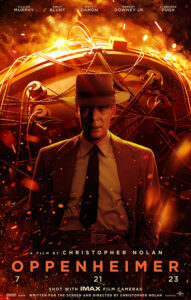 There are occasions when the full resources of the American film industry produce a searching, creative, and important film that will stand the test of time. Arguably, Oppenheimer, a $100m film about the history of nuclear weapons, is one such instance. At the time of writing the film has taken $730m at the world box office and has been seen by millions of people, sparking conversations about nuclear weapons and their continued role in the world. This blog offers some ways in which teachers might engage with learners who may have watched the film (alongside Barbie!) during their summer holidays.
There are occasions when the full resources of the American film industry produce a searching, creative, and important film that will stand the test of time. Arguably, Oppenheimer, a $100m film about the history of nuclear weapons, is one such instance. At the time of writing the film has taken $730m at the world box office and has been seen by millions of people, sparking conversations about nuclear weapons and their continued role in the world. This blog offers some ways in which teachers might engage with learners who may have watched the film (alongside Barbie!) during their summer holidays.
At first glance it seems fair to say that nuclear weapons and their use are not very often directly addressed by Hollywood, which after all seeks to entertain. However, in Atomic Bomb Cinema (Routledge, 2002) Jerome F. Shapiro reveals that since World War II around 4% of each year’s films address a pervasive cultural anxiety about nuclear weapons. After World War II, for example, spy films quickly exploited people’s fears. In Alfred Hitchcock’s Notorious (1946) a cache of uranium hidden in wine bottles is a key plot device and deadly Doomsday weapons are often at the centre of contemporary films that will be more familiar to school pupils such as the Bond and Mission Impossible franchises. Indeed, some of Nolan’s films pay homage to these earlier spy films: Tenet shows a struggle to control a potentially world-ending technology called the ‘Algorithm’.
From the 1950s, mutant monster films riffed on a widespread nuclear anxiety. In Them! (1954) giant irradiated ants rampage through the New Mexico desert. In Beast from 20,000 Fathoms (1953) a deadly dinosaur is unearthed from the arctic sea ice by a nuclear bomb test. And in Attack of the Crab Monsters (1957) mutated giant crabs on a Pacific island absorb the minds of the scientists conducting nuclear tests. Contradictorily, these mutant monsters are invariably defeated by nuclear weapons, thereby reassuring the audience of their necessity. This type of film remains popular, with Godzilla (latest instalment 2021) retaining the contradictory nuclear anxiety/pro-nuke logic and the Terminator franchise (2019) recognisably influenced by the B-movie DNA of this 1950s cycle.
In the 1960s, and especially following the Cuban Missile crisis (1962), films with a more direct address of nuclear war as well as a more critical sensibility began to appear. Fail-Safe (1964) shows the aftermath of the accidental detonation of a US nuclear weapon on Moscow and Stanley Kubrick’s Dr Strangelove (1964) adopted a serious but satirical approach. Oppenheimer inherits the serious mindedness of these films and is an important step in the development of atomic bomb cinema, moving the issue out of the shadows of subtext, B-movie sensationalism, and science-fiction.
Of course, the central question for an anti-nuclear campaigning organisation such as CND, is whether the film is pro-nuclear disarmament. To sell the maximum number of tickets, Hollywood films will usually seek to accommodate a wide range of possible views on any given topic, and this is partly true of Oppenheimer. The film indicates that building the atomic bomb is necessary to head off the threat of the Nazi’s nuclear weapons programme. This corroborates arguments about the need to have nuclear weapons to defend against totalitarian and rogue states via deterrence. In addition, the depiction of the Manhattan Project as a near utopian gathering of politically disparate but brilliant intellectuals finding common cause in a world-leading anti-racist and anti-fascist science and technology project maintains credibility for nuclear weapons.
Additionally certain omissions have been noted as problematic, especially the failure to show the Japanese experience of the bomb [https://www.latimes.com/entertainment-arts/movies/story/2023-08-04/oppenheimer-movie-christopher-nolan-atomic-bomb-hiroshima-nagasaki-critics] and the film’s silence on the toxic impact and legacies of nuclear testing in the US and abroad [https://www.theguardian.com/environment/2023/aug/25/endless-fallout-marshall-islands-pacific-idyll-still-facing-nuclear-blight-77-years-on]. And while Nazi anti-semitism is shown to be a key motivation of Oppenheimer, there is a failure to acknowledge US anti-semitism (as well as racial and class discrimination).
However, anti-nuclear campaigners have largely welcomed Oppenheimer as useful to the cause of nuclear disarmament [https://www.theguardian.com/world/2023/jul/21/anti-nuclear-groups-welcome-oppenheimer-film-fails-depict-true-horror]. The film shows Oppenheimer’s guilt regarding the use of the atomic bomb against Japanese cities (leading to the immediate deaths of 210,000) and his subsequent shift to anti-nuclear campaigning via the call for non-proliferation and international regulation. The film also qualifies the dominant view that World War II was a war of good (the United States) versus evil (Nazi Germany). The film depicts a war being fought on multiple fronts and, in anticipation of the Cold War, it takes care to show how the pivot to the Pacific theatre as the point of first use for nuclear weapons leads to a loss of consensus among scientists about whether the bomb should be used.
The film’s political drama shows the potential catastrophe of nuclear holocaust hanging in the balance, with Oppenheimer’s scientists (and the film’s viewers) placed in opposition to craven, self-serving and short-sighted politicians. The film’s final image of a firestorm devastating the earth implies that the redemptive ending we usually expect from Hollywood films is only available via human action beyond the cinema: committing to de-escalation, international peace treaties, and the decommissioning of nuclear weapons as part of the wider changes needed to protect the planet in response to the climate crisis.
Dr Guy Westwell, Head of Film at Queen Mary University of London and CND Peace Education School Speaker
You might also find the lessons from Teach Peace Secondary useful: https://www.quaker.org.uk/news-and-events/news/peace-education-network-offers-free-lessons-on-oppenheimer-s-legacy-as-new-film-released along with CND Peace Education resources which teach about nuclear weapons and the bombing of Hiroshima (particularly: The Bomb Factor, Sadako’s Cranes for Peace, Truman on Trial, Dial M for Missile and Critical Mass).
The acclaimed poet (and CND Peace Education Patron), Antony Owen has written the following poem in response to the film which you are free to use:

Dear Mr Oppenheimer
Beneath your crafted nebula
I picture your dead noon walk
casting a long shadow eastward.
In the post atomic abendrot
you brush off Alamogordo sand
like glitter from a forbidden kiss.
Dear Mr Oppenheimer,
sky is badged in yellow stars,
magenta stars, violet dust.
Dear Mr Oppenheimer,
this night your star was born
sunset bled over Hiroshima.
At the IMAX film of your life
a man scoffs bulb warm Dorito’s
sharing his awe on TikTok –
the new age Brittanica.